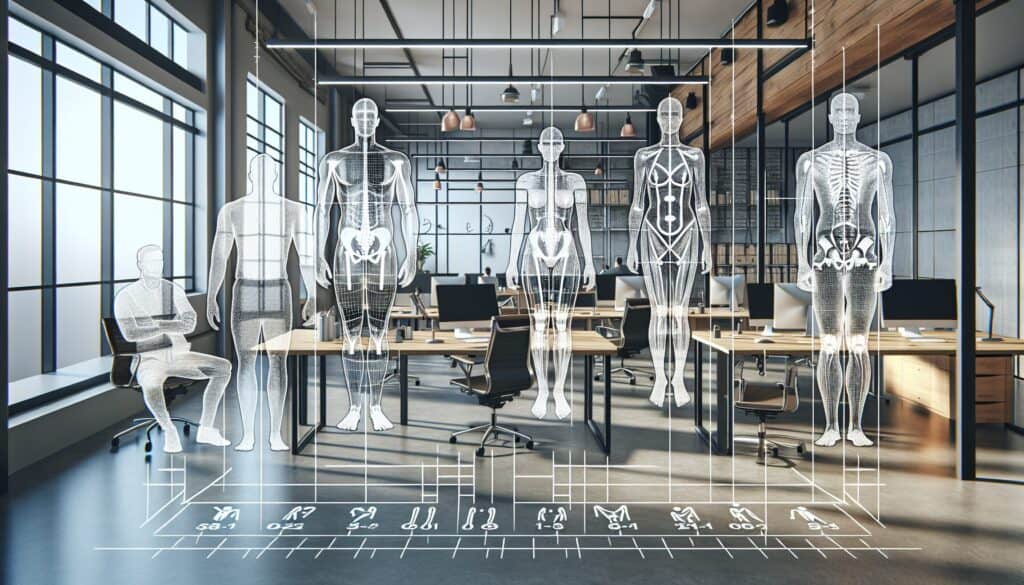The study of human body measurements and proportions to inform the design of workspaces, equipment, and products to fit the user population.
- Methodologies: Customers & Marketing, Ideation, Product Design
Anthropometric Analysis

Anthropometric Analysis
- Design for Additive Manufacturing (DfAM), Design for Manufacturing (DfM), Design Optimization, Ergonomics, Human Factors, Human-Centered Design, Usability, User experience (UX), User-Centered Design
Objective:
How it’s used:
- Involves using anthropometric data (e.g., height, reach, limb lengths) of the target user population to ensure that designs are dimensionally compatible with their physical characteristics.
Pros
- Helps design products and environments that are comfortable, safe, and efficient to use for the target population; reduces physical strain and errors; can improve user satisfaction.
Cons
- Anthropometric data varies by population (age, gender, ethnicity) and needs to be current; designing for a wide range of users (e.g., 5th to 95th percentile) can be challenging; static measurements may not fully capture dynamic task requirements.
Categories:
- Ergonomics, Product Design
Best for:
- Using human body measurements to design workspaces, tools, and products that fit the intended users.
Anthropometric Analysis applies extensively across various industries, including ergonomics, industrial design, and healthcare, facilitating the creation of tools, equipment, and workspaces that are inherently user-centric. This methodology is often employed during the early stages of product development, typically in user research and concept design phases, where understanding the physical characteristics of the target user population is pivotal. Participants in this process include product designers, engineers, ergonomists, and market researchers, who collaborate to gather and analyze anthropometric data relevant to their specific demographic. Industries such as automotive and aerospace rely heavily on this analysis, ensuring that vehicle interiors and control interfaces accommodate diverse user heights and body shapes, thereby enhancing safety and comfort. Similarly, in healthcare, ergonomic design of medical instruments and patient handling equipment is informed by anthropometric data, directly impacting healthcare outcomes through improved usability. The application extends to consumer products like furniture, where knowledge of human dimensions informs the ergonomic design of chairs and tables, ensuring that they can be used comfortably across a broad range of body sizes. This attention to anthropometric details not only reduces physical strain but also minimizes the risk of injury and errors during use, thereby enhancing operational efficiency and user satisfaction in multiple contexts.
Key steps of this methodology
- Identify the target user population and their representative anthropometric data.
- Select relevant dimensions based on specific tasks or interactions required by the design.
- Analyze the distribution of the selected data to determine the design limits (minimum and maximum values).
- Create design envelopes that accommodate the diverse range of body sizes and shapes within the user population.
- Iterate design concepts based on ergonomics principles and user interface interactions.
- Prototype and evaluate designs with a sample of the target population for usability testing.
- Refine designs based on feedback and performance observations to enhance fit and comfort.
Pro Tips
- Incorporate segmental data to refine ergonomic assessments, focusing on the distribution of body proportions among different demographics.
- Utilize dynamic anthropometry by assessing movement patterns and workspace interactions to create adaptable designs that accommodate varying user scenarios.
- Implement iterative prototyping based on anthropometric data to validate design dimensions through user testing, ensuring comfort and functionality align with real-world applications.
To read and compare several methodologies, we recommend the
> Extensive Methodologies Repository <
together with the 400+ other methodologies.
Your comments on this methodology or additional info are welcome on the comment section below ↓ , so as any engineering-related ideas or links.
Historical Context
1986
(if date is unknown or not relevant, e.g. "fluid mechanics", a rounded estimation of its notable emergence is provided)

Related Posts
Musculoskeletal Discomfort Questionnaires
Multivariate Testing (MVT)
Multiple Regression Analysis
Motion Capture Systems
MoSCoW Method
Mood’s Median Test